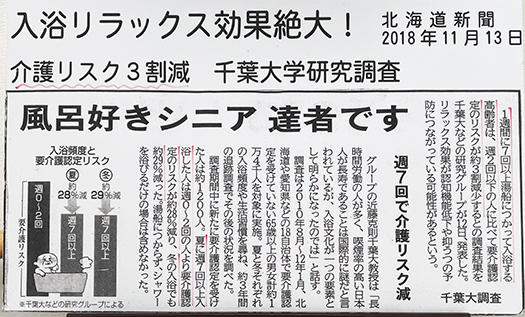
今回の青森−道南観桜旅、青森からフェリーで帰還後、夫婦旅の定番・函館市内の「谷地頭温泉」へ。この温泉は「公営温泉」として長く函館市が経営していた歴史があり市民に親しまれてきた。歴史的には以下のよう。(概略Wiki記述より)
〜1878年の函館大火のあと当時湿地帯であった谷地頭地区が宅地造成され1881年竣工。翌1882年事業家・勝田銀蔵によって温泉掘削が行われた。その源泉に対し戦後直後、函館水道局(現、函館市企業局上下水道部)に新しい湯元の開発が持ちかけられた。ちょうど湯の川温泉の温泉供給管に付着するガリ対策の目処がついたこともあり、1949年8月にかつてあった料亭「浅田楼」の土地(谷地頭町25番地)購入する施策案が函館市議会で決議。翌1950年に市民より谷地頭町17番地も寄付され1951年ボーリングを実施して源泉開発が行われ、1953年2月に市営谷地頭温泉として開業した。しかし1998年をピークに利用者数が落ち込み、翌1999年から赤字が続いていたため、2013年4月に函館市から株式会社ケーケーエムに建物等が売却され民営化されて今日に至っている。〜

ちょうどわたし自身の生年時期に公営温泉として開業し、約60年後の今から12年ほど前に役割を終え民営化されたのだが、なにか自分自身の人生行路と並行するような感覚がある。
実はわたしは函館に奇縁があって、子種に恵まれなかった函館在住の叔父がわたしを養子に欲しがっていたのだ。叔父の姉である母は末子であるわたしを連れて各地を探訪したけれど、函館にはなんども訪問した記憶がある。母はわたしに一生残る特異なコトバの記憶を残した。それが「叔父さんのところに養子に行くか?」という打診。わたしは即座に「絶対イヤだ!」と叫んでいた。その肉声はいまも心底に横たわっている。
・・・それでその件は沙汰止みになったのだけれど、当のわたしの内部には記憶が深く沈殿せざるを得なかった。五稜郭やこの谷地頭温泉、函館の庶民感覚への「愛着」の断片に、そのことが関わっているように思える人生を過ごしてきた。「もしもあのとき」心理。そして母の心事にこころが至っての愛惜の情感。
谷地頭の温泉に浸かって「地元民」的にいっとき過ごすことが、いつか定番化した。
ふと、温泉の暖簾に目が止まってカメラに収めていた(笑)。この和歌は男女の縁を詠ったとされ、事実、女風呂にも十二単のような衣装の女性が描かれた暖簾があったけれど、和歌の意味、言の葉がより深く、感受されていた。・・・
English version⬇
Hakodate is the local people's staple ‘Yajigashira Onsen’.
A sense of affection for Hakodate ‘Jimottee’ and a faint, deep sense of impermanence. The words of the phrase ‘Seho-yami iwa ni sekaruru’ (‘I will never give up on a rock’) after going through life's journey. ...
On this Aomori-Donan cherry blossom viewing trip, after returning by ferry from Aomori, we went to Yajigashira Onsen in Hakodate City, a regular destination for couples travelling together. This hot spring has a long history of being run by Hakodate City as a “public hot spring” and is well known to citizens. The history is as follows. (From Wiki description)
- After the Great Hakodate Fire of 1878, the Yajigashira area, which was a swampy area at the time, was developed into a housing estate, which was completed in 1881. The following year, 1882, the hot spring was drilled by the entrepreneur Katsuta Ginzo. Immediately after the war, the Hakodate Waterworks Bureau (now the Water Supply and Sewerage Department of the Hakodate Municipal Enterprise Bureau) was approached to develop a new hot spring source for the source. In August 1949, the Hakodate City Council passed a resolution to purchase the land (25 Yajigashira-cho) of the Asadaro ryotei (Japanese-style restaurant), which had previously been located there. The following year, in 1950, citizens donated 17 Yajigashira-cho, and in 1951, drilling was carried out to develop the source, which was opened as the municipal Yajigashira Onsen in February 1953. However, the number of visitors peaked in 1998 and the spa had been losing money since 1999, so in April 2013 the building was sold by Hakodate City to KKM Co. ~
It was opened as a public hot spring just at the time of my birth, and about 60 years later, about 12 years ago, it finished its role and was privatised, but I have the feeling that it parallels my own life path.
In fact, I have an unusual connection to Hakodate, where my uncle, who lived in Hakodate and was not blessed with any children, wanted to adopt me. My mother, my uncle's sister, took me, his youngest child, to visit many places, and I remember visiting Hakodate many times. My mother left me with a memory of a peculiar word that will stay with me for the rest of my life. She asked me if I wanted to be adopted by my uncle. I immediately said, ‘Absolutely not’. I immediately shouted, "Absolutely not! I immediately shouted, "Absolutely not! That voice still lies deep in my heart.
... and so the matter was put to rest, but the memory had to settle deep down inside me. I have spent my life feeling that it is part of my “attachment” to Goryokaku, this Yajigashira hot spring and the common people's sense of Hakodate. The ‘what if then’ mentality. And the feeling of regret when one's heart is touched by one's mother's affairs.
Soaking in the hot springs of Yajigashira and spending a few moments in a “local” way became a regular occurrence.
Suddenly, my eyes stopped on the noren (curtain) of the hot spring and I took a picture of it with my camera (laughs). This waka poem is said to be about the bond between a man and a woman, and in fact, there was a curtain in the women's bath with a woman dressed in a juni-hitoe-like costume, but the meaning and words of the poem were more deeply felt and appreciated. ...




























※コメント投稿者のブログIDはブログ作成者のみに通知されます